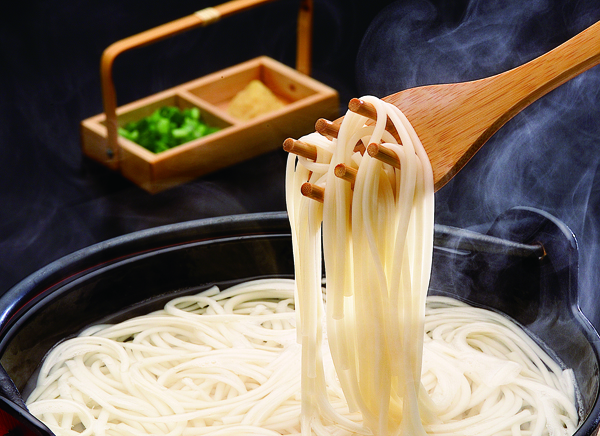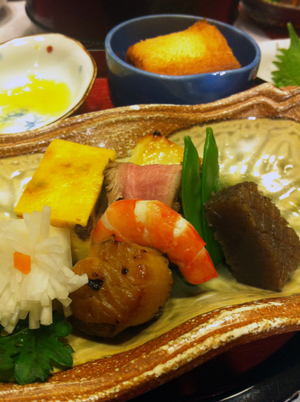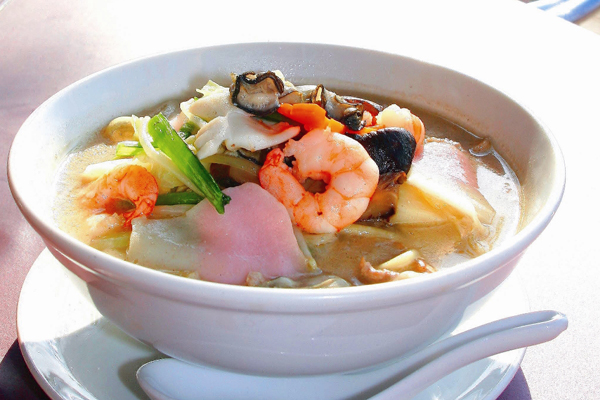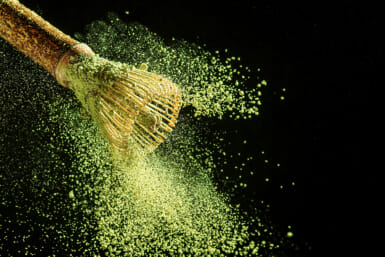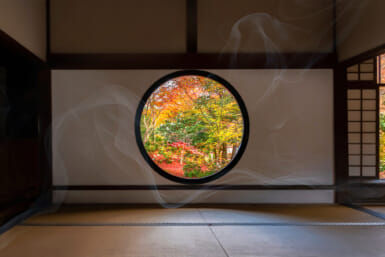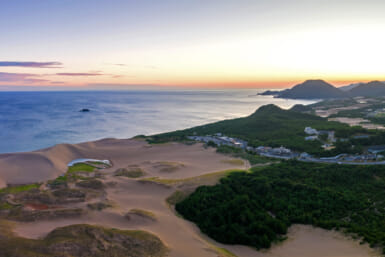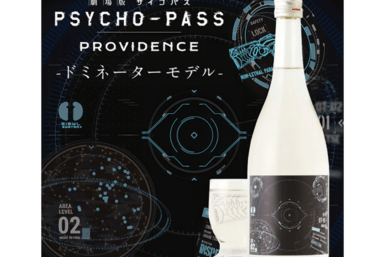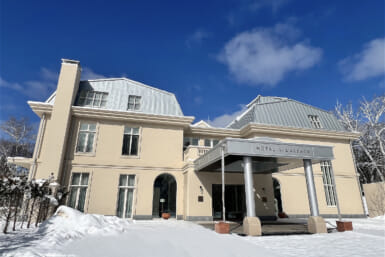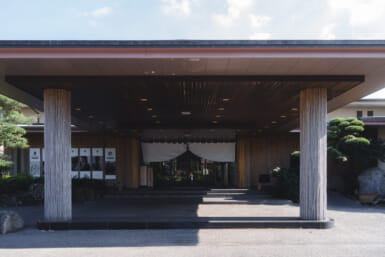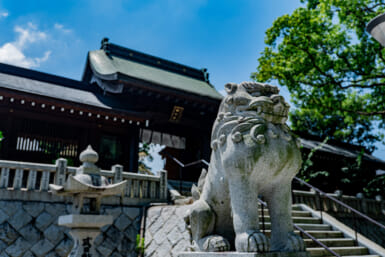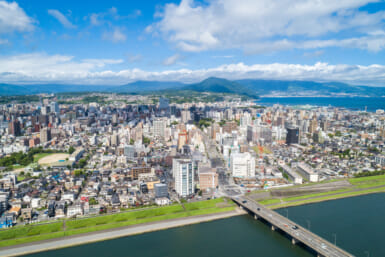You’ve got to eat, especially after discovering the best of Nagasaki or seeking Japan’s Hidden Christians. In Japan, you won’t go far without someone proudly telling you – or hundreds of colorful signs exclaiming – just what the local speciality is.
By Matthew Holmes
Nagasaki and its surroundings are of course no exception, so we have rounded up six dishes (each a key local meibutsu – famed local products of a region) you must try while you’re there, and some reasons why we loved them!
Goto Udon (pictured above)
“It’s like a kind of wafu (Japanese style) carbonara,” says our local companion of one of the ways we’re taught to dip our thin local udon noodles on Nakadori Island. As we watch them boil in a cast-iron pot in the middle of the table we mix finely chopped negi (scallions) with katsuobushi (fish flakes) and an egg in the small pot that awaits their arrival a few minutes later.
Then dip them we do – the steaming noodles kind of half cook the egg and, with a dash of soy sauce we found each mouthful to be satisfying and creamy, with a more delicate flavour than expected. Yes, it kind of is like Carbonara and definitely one to try and replicate back home.
Try it at: Lunchtime for us on Nakadori Island meant a trip to Yumezanmai (428-31 Arikawago, Shinkamigoto-cho) and we were advised there’s nowhere better to try the dish. The restaurant was busy with regulars and fishermen as well as the odd local tourist and the adjacent gift shop has what seems like hundreds of options, each made by a different local farmer/maker, for those wishing to take some noodles home. Local stock made from flying fish – called agodashi – is also popular.
Castella
Before you taste it, you might see keyrings, mobile phone straps, T-shirts, mascots and plenty of pictures devoted to the celebration of castella – on the steep hill you’ll walk up on your way to Glover Garden there’s even a Castella Shrine.
All this for what is basically just a sponge cake seems a little over the top but it really is rather nice, and you can’t come without at least taking some home as the must have Nagasaki omiyage. You’re right if you think the name sounds more European than Japanese – it comes from the Portuguese spoken by merchants from that country who first brought the bread/cake that inspired it in the 16th century.
Try it at: You won’t go far without seeing a store. Our tip? Say yes to as many free samples as you can!
Shippoku Ryori
What do you get if you cross European, Chinese and Japanese cooking? In Nagasaki, the answer is Shippoku, a blend unique to the city.
The local cosmopolitan character and history of welcoming immigrants is usually evident throughout what seems a fairly Chinese style banquet setting; courses are presented at once and guests are truly treated well. You could spend a fortune or go for something mid-range but whichever you choose, you’re in for a feast.
Steamed snapper may come with egg dumplings in soup, you’re likely to see sweet beans, crispy fried shrimp toast, pickles, sashimi and plenty more in your lacquer ware dishes.
Often the star of the show, though, is kaku ni, a well-marbled square of pork belly that at first looks pretty Chinese but which is simmered very slowly with Japanese staples – the mirin/soy sauce/dashi/sake combo – and served with a sharp portion of karashi mustard to cut through the fat.
Try it at: Hamakatsu (Tel: 095-826-8321; www.sippoku.jp) which will cater to your hunger/budget with whatever kind of course you fancy. We visited early on a Friday evening and its large tatami room was full of locals – always a good sign.
Nagasaki Champon
Ah, noodles in a broth. What part of Asia doesn’t have its version? Each area has put its own spin on the classic combo and Nagasaki is, famously, no exception.
The mid-Meiji period saw a glut of Chinese students heading to the city and one restaurant – so it says – saw the opportunity to create a cheap and filling meal for them; Shikairō in fact still exists but is slightly more likely to cater to crowds of tourists at the Glover Garden than those seeking authenticity.
Cooks shred and spread cabbage, bean sprouts, mushrooms, pink and white kamaboko (fish paste) and plenty of other seasonally available seafood and meat (usually shrimps, sometimes shellfish such as oysters and often both chicken and pork) and place it all atop noodles that are cooked in the broth itself.
Try it at: There are many great spots around the city. Word of mouth led us to an enjoyable lunch at Mantoku, on the outskirts of Chinatown near Nishihamanomachi streetcar station and we were later pleased to have discovered that even Botan, at Nagasaki Airport, was not simply catering to a captive audience – it was good, with an earthy soup (was that the mushrooms?) that made us want to stay a few more days.
European and American Cuisine
All this European influence is not necessarily mixed with Asian cuisine.
Nagasaki is a great place to eat non-Japanese food: from fairly traditional trattoria serving pizza and the like to French style bistros taking advantage of their location with a focus on fresh seafood to go with imported wine, most visitors will find something they like.
There are many upscale hotels in the city, some of which have restaurants with a view over the harbour from high-rise buildings or their perches on the hills surrounding the city and a string of seafood restaurants overlook the port nearby Nagasaki Prefectural Art Museum.
Try it at: NY Dining at the Best Western Premier offers courses using famous Nagasaki beef cooked either western or Japanese style in a Manhattan-inspired setting overlooking almost the whole of Nagasaki bay. Have a plan: many restaurants close earlier than in Tokyo or will be full by the time you head for dinner if you go out much after 7pm.
Sara Udon
A plate of noodles, literally. So what’s so special? In the whole grain wheatiness of the crispy noodles that sit under various stir-fried Chinese style vegetables and seafood staples we found a hearty and satisfying lunch.
These are almost as popular as champon (in fact you can substitute for the thicker noodles usually in that broth for a kind of hybrid in many places) and it’s not difficult to spot a good location. Ever seen Ringer Hut in Tokyo?
The chain hails from Nagasaki, serves both of these dishes and is named after Fredrick Ringer, an Englishman who was influential in the booming Nagasaki of the late 19th century (he helped develop a mechanical flour mill, petroleum storage and a steam laundry system). His Ringer House – with a roof the Hut mimics – was built within the Glover Garden in 1865. If ever you can dine at a chain without feeling you’ve copped out…
Try it at: See above!

